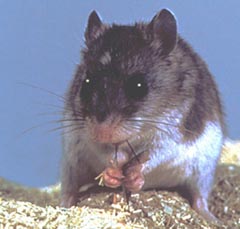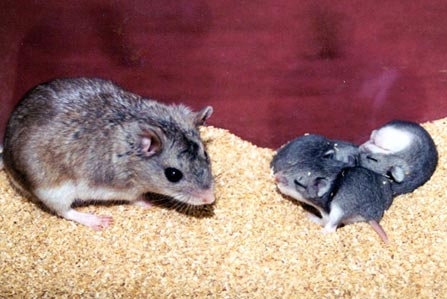 A Northern Grasshopper mouse eats a cricket.(Courtesy of R.S. Sikes, University of Arkansas at Little Rock)
A Northern Grasshopper mouse eats a cricket.(Courtesy of R.S. Sikes, University of Arkansas at Little Rock)[FAINT HIGH PITCH BUZZ]
RICE: Did you hear that? Maybe not. Here's the thing. As mighty as the howl is, it's really, really high pitched. And that's a problem for our puny human hearing. We hear frequencies as high as 20,000 hertz. And that's if you have just about perfect hearing. The Grasshopper mouse howl gets up to almost 14,000 hertz. Hear it on your car radio? Not likely. It works better if I lower the pitch by slowing it down.
[SLOWED DOWN HOWL; LOUDER THAN BEFORE]
RICE: There you have it. The howling mouse of the prairie.
[SLOWED DOWN HOWL]
RICE: So here I am, out in the desert trying to capture it on tape.
[CRICKETS, OWL SCREECHING]
RICE: Nearby, what look like two owls fight in the darkness.
[OWL SCREECH]
RICE: But the Grasshopper mouse remains elusive. If I want to be assured of hearing one in person, I need to go a little farther afield.
[SQUEAKY DOOR]
SIKES: Ok, we're in the Basic Animal Services Unit at the University of Arkansas at Little Rock. We are housing currently just slightly over 600 of these Grasshopper mice. These are Northern Grasshopper mice.
RICES: At exactly 7:30 every night here, the lights go out in Dr. Sikes' grasshopper mouse lab. And every night the howls begin.
[FAINT HIGH-PITCHED HOWL]
RICE: These mice are nocturnal, and are most likely to howl in the darkness. So, here we are, surrounded by hundreds of mice in cages, in the pitch black. I can't see my microphone in front of my face. At this point, I think what the hell am I doing here? But suddenly, Dr. Sikes becomes very excited.
SIKES: Right now, they are vocalizing like crazy in this room. We simply can't hear it. We hear the tiniest tip of the iceberg of what's actually going on. You can hear the mice moving around a lot here.
RICE: Mostly, what I'm hearing is the chewing of food pellets. And I admit that trying to listen to sounds that other people don't hear is the definition of insanity. Especially when it comes to howling mice.
Just ask graduate student Tommy Finley.
FINLEY: You’re talking about people thinking you're crazy, really. They think I'm crazy spending my Friday and Saturday nights up here listening to Grasshopper mice howl all night. [LAUGHTER]
RICE: But then, every once in a while, out of the darkness, there is a prolonged squeak--like a rusty hinge.
 A Northern Grasshopper mouse and her litter.
A Northern Grasshopper mouse and her litter.
(Courtesy of R.S. Sikes, University of Arkansas at Little Rock)
[CAGES BANGING]
RICE: Ooh, he howled right there.
FINLEY: You see?
RICE: Yea.
[FAINT HIGH PITCHED HOWL]
SIKES: In fact, one mouse may be starting a call, a long loud call. And then immediately one or more mice will join in.
RICE: A pack of mice howl wolflike in the dark. It is all that I had imagined.
The meaning of the howl seems pretty apparent. Scientists think that it is territorial, in much the same way that a wolf's howl is territorial. Grasshopper mice have large ranges for their small size. Up to five acres, and the high-pitched howl will carry over a large distance. Dr. Sikes says the fact that a mouse howls and even looks like a wolf when it's doing it makes perfect sense.
SIKES: That would be the posture that I would take. You want to channel that emission where there's going to be the least interference, i.e. up. Not down into the ground. Not into the vegetation. But get it up. So I think that posture is probably correct. Also, if you watch singers, typically they don't sing when sitting down.
RICE: It's comforting to find that the same laws of nature that govern wolves, also govern mice – and men.
[NARRATOR HOWLING IN BACKGROUND]
RICE: For Living on Earth, I'm Jeff Rice in the Idaho desert.
[NARRATOR HOWLS]
[MUSIC: Elliot Smith “Bye” FIGURE EIGHT (Dreamworks – 2000)]
CURWOOD: Our story on Grasshopper mice is part of the “Hearing Voices” series that is funded, in part, by the Corporation for Public Broadcasting.
[MUSIC: Elliot Smith “Bye” FIGURE EIGHT (Dreamworks – 2000)]
Listen to a sample of the mouse's howling at normal pitch:
Links http://www.ualr.edu/~biology/sikes.html - Prof. Robert Sikes webpage